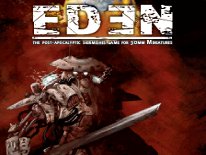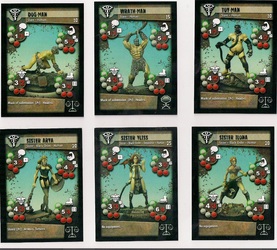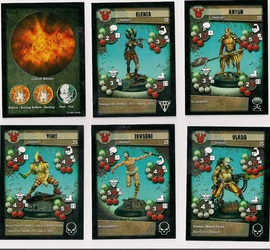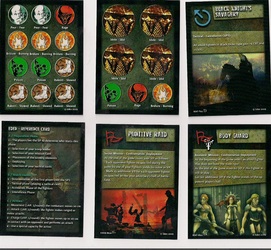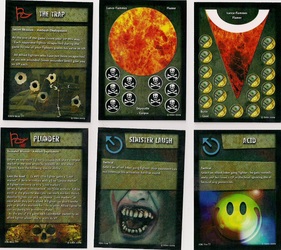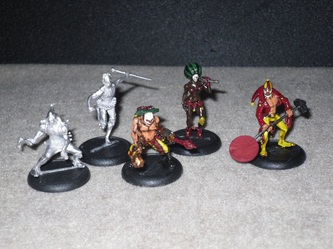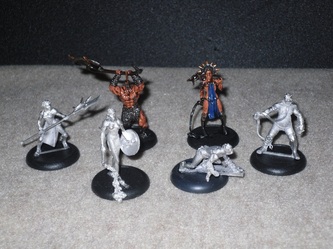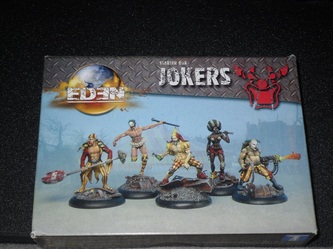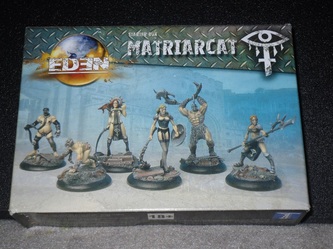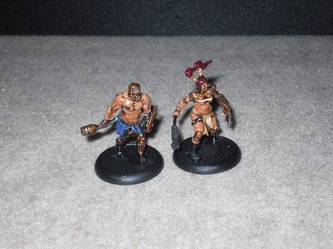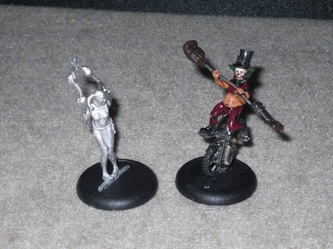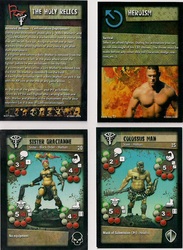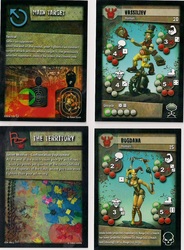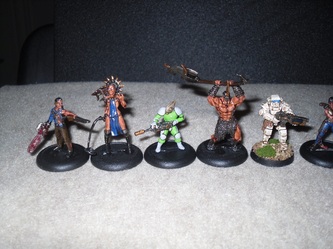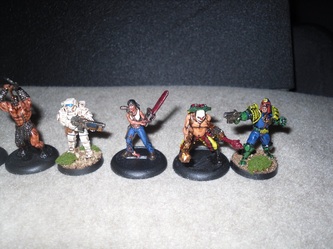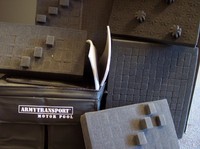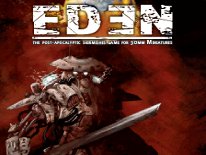|
September 6th, 2010
In Focus Review - Eden Taban Miniatures is a French company, and they've been creating a variety of miniature models for a number of years now. They're also the company responsible for the post apocalyptic skirmish game Eden. Today I'll introduce you to a variety of models from Taban Miniatures for Eden, and provide you with an in-depth review of the game of Eden itself.
Enter Eden... There's four factions in Eden to choose from the Jokers, Bamaka Clan, Matriarchy and ISC. Each are very unique in presentation. For instance the Jokers as the name implies, is a group of what appear to be not so nice circus clowns and performers. Knife jugglers, flame thrower toting clowns; it's a unique bunch of performers to say the least. The ISC look like techno-samurais, as it's a very feudal Japan-inspired faction, but on a cybernetic level, as they all appear to be robot/droid-like in presentation. The Bamaka Clan at a glance look like some sort of Voodoo practicing/head hunting tribe. All of the models in this faction appear to be African-American, and are all dressed in primitive tribal garb. Lastly the Matriarchy is clearly the faction made up of bondage/dominatrix types. They're all wearing what appear to be leather, spikes, chains, whips, etc. As you can see, there's some really diverse and unique factions in this game for sure. This is a game that utilizes models which comes with their own full color stat cards. There's 3 different card types in Eden as well. There's Profile, Mission and Tactical Cards available. The Profile cards are the stat cards for each model. There's a variety of information available on the face of a Profile card. The Name and Faction Symbol are at the topmost section. Right under that will be the Type and Value. The Value reflects how powerful or efficient the model is, and this is the value used to create your force from. Type just tells you if they're human or what not. Next you'll find four different Limb sections, broken down into Torso, Head, Arms and Legs. Each Limb has its own Constitution Value, which is represented by the white/red dots to the side of each Limb, and this represents how many wounds each Limb can take. If a white dot is still showing the Limb functions as normal, but once you reach the red dots, that limb is now considered Wounded. Run out of red dots and that model becomes Incapacitated. There's two Characteristic stat values listed for each Limb as well. If operating as normal you use the normal stat on the left side of the slash in white, if it's a wounded Limb you're to use the lower stat to the right of the slash in red to reflect being Wounded. This is very much like the system used in Freebooter's Fate, and I like this system a lot. It just makes sense. The Characteristic PSI (PSI) is linked to the Head, fighting skill (CBT) is linked to Arms, Vigor (VIG) is linked to the Torso and Speed (SPD) is linked to the Legs. There's also images of little D6 dice values, found on the card in the same area as the Limbs. This is called the Location Index. A result of 1 is next to the Head Limb, a result of 4 and 5 is shown next to the Torso, a result of 2 and 3 is next to the Arms, and the value of 6 is linked to the Legs. So when rolling for what part of the body is hit, a single D6 is rolled, and the result of this roll is matched up with the Location Index on the Profile card of the model you're attempting to wound. At the very bottom of the card you'll find any Equipment that the model may have, which includes but isn't limited too shields, throwing knives, Molotov cocktails, Mask of Submission, etc. Lastly there's a Stigma Symbol to be found in the lower right-hand corner of each card. Protection, Chaos, Order, Change and Destruction are the Stigma Symbol possibilities. On the back of each card is where you can find any Special Abilities exclusive to each model too. The Mission Cards come in two types, Revealed and Secret Missions. As you may have guessed, a Secret Mission card can be left face down, and doesn't require being revealed to the opponent. A Revealed Mission is the opposite, it can be refereed to and read by an opponent at any time during the game. Each Mission Card also details the type of deployment from Confrontation or Ambush, which is used during the Preparation Phase. The Mission Objective is also detailed on the face of a Mission Card, which also tells you how many Victory Points (VP) will be earned by completing the objective(s). There can also be a Faction/Stigma Symbol on each card, and this determines which Faction/Models can take part in the mission. Some cards are exclusive to specific Factions, or troops with a specific Stigma symbol. For instance, two of the Mission Cards that come with the Matriarchy Starter Set are exclusive to the Matriarchy since those two cards have the Matriarchy Faction Symbol on them. However, the other remaining two Mission Cards can be used by any Faction/Stigma Symbol, since there's no Faction/Stigma Symbol on them. Tactical Cards feature the name of the card, and only one of each named Tactical Card can be played per game. There's a variety of special rules for these cards, they are Tactical, First Round and Cancellation X. Cards marked Tactical can only be played during the Tactical Phase. First Round cards as the name implies can only be played during the first round of the game. A Cancellation X card is different, because once set into play, the opponent can pay X number of Strategy Points to cancel the effect(s) of this card. There's three types of rolls in the game Characteristic, Opposition and Location. Characteristic is a threshold type of roll against a characteristic. This is achieved by rolling an equal number of D6 to the Characteristic in question, and all rolls equal or greater than the threshold are a success. Opposition Rolls would be a combat roll, where you and the opposing player is rolling off to win a combat. This is achieved by taking the CBT value of each model, rolling a single D6 and adding that result to the CBT value, and the one with the highest combined result wins. If there's a tie the model with the highest CBT value alone wins the tie, and if both models have the same CBT result, then both combatants roll again until there's a clear winner. Location roll we covered earlier, which is a single D6 roll against the Location Index on a Profile card. Setup and Preparation Phase
The game takes place on at least a 60cm by 60cm play area, which is roughly 2ft by 2ft square. They suggest that as the norm too, which is quite small, but you also get into the thick of things faster with such a small play area. You can just as easily play on a 3ft by 3ft, or 4ft by 4ft surface, or larger as well like most other skirmish games. Each force, or army is called a Troop in Eden. Troop composition is quite simple. A Troop can be formed via Faction or Stigma Symbol only. They also suggest 100-point's per side size games, and not to use more than 200-points per side. So it's very clear this is truly more of a skirmish-size affair than a wargame meant to be played out with large numbers of models. This also keeps Eden from being a hefty financial investment. The Starter boxes for Jokers and Matriarchy also add up to exactly 100-points each, and all of the starters are exactly 100 point boxes. After each side has a legal Troop, it's now time to begin the Preparation Phase, this is when each player can double check the other players Troop to see that it's legal. This is also the phase to determine who goes first. This is determined by betting Strategy Points (SP). Each side adds up the total number of PSI values in their troop, and this reflects the pool of SP they have. This can be represented by beads off to the side of the playing area, coins, etc. Now once each side knows how many SP they have, each player writes down on a piece of paper how many SP they want to Bet, and places this paper in their hand. Both players simultaneously open their hands, and the player who bet the most SP gets to go first. These SP are also lost and now deducted from the SP pool, regardless if they win or loose the bet. The first player now designates the Leader of his Troop, and after the opposing player does the same. Next the First player chooses a Mission Card and sets it into play. If it's a Secret Card he leaves it face down next to the play area. Now the Second player reveals his Mission Card and sets it into play. Next both players take turns placing any scenery, and it has to be an equal number of scenery, so that both players set the same number of pieces down. The Optional Infestation Rule can be set into play now, which would determine the Non Player Fighter/Creatures deployment. . Now Deployment occurs, depending on the type of deployment defined by the Mission Card. The field is separated into two equal size parts for each side, and the first player chooses which part he wants first. A Confrontation Deployment forces the player to deploy 20cm or more from the Center Line of his own half of the play area. An Ambush Deployment is similar, but instead of the Center Line, the troops are deployed 20cm or more from the total Center point of his area, limited by a circular curve. The next step has the first player selecting a number of Tactical Cards equal to the PSI value of his Troop Leader model. This is called the Tactical Hand. The other player does the same, the only limitation is you can't have two of the same named Tactical Cards. Tactical Cards can only be played during the Tactical Phase too, and it cost 2 SP to play any Tactical Card. If you don't have at least 2 SP in your SP pool, or if your Leader is no longer on the field, you simply can't play any Tactical Cards either. Effects from a Tactical Card last only one round of play too. That's it for the Tactical Phase. Activation Phase of Fighters
Now is what they call the Activation Phase of Fighters. Each model on the playing field is given 3 Action Points (AP) to perform actions with. Actions are as follows Movement (Cost = 1 Action Point, and 3 Movement Actions maximum are allowed per Round), Charge (Cost=1 AP, 1/Round) and Attack (Cost=1 AP, 2/Round). To begin the First player selects a model, then announces the name and SPD value of that model to his opponent. At this point the other player has the option to Interrupt that player, as long as he has a model that hasn't activated yet, and that has a higher SPD value. This can go back and forth as long as both sides meet the requirements for Interrupting too, so it can get messy quite fast. Both sides continue to alternate activating models and performing actions until both sides have used all of their models. Combat Attacking is fairly straightforward, although Melee and Ranged are somewhat different. The attacker is considered an Initiator, and the defender is defined as the Target via the rulebook. The Initiator must be in base contact with an opposing model to make a Melee attack. This is usually achieved via the Charge. Once the Initiator declares a Melee attack, the Target can now choose one of three types of Reactions. The choices are Passive Reaction, Response Reaction and Dodge Reaction. The Passive Reaction route has the Initiator making a CBT roll (equal number of D6 as the CBT value) with the VIG value of the target being the difficulty, meeting or exceeding the Target's VIG is a success. At the same time the Initiator performs a Location Roll. Each successful roll against the Target's VIG can be used to modify the result of the Location Roll by + or – a digit in either direction. You're essentially fine tuning where you are hitting the Target. Each remaining success inflicts 1 wound to the Limb hit. The Response Reaction is similar, yet different. A Response Action costs the Target 1 AP, and counts towards one of the allowed Attacks for that round. The difference is, both the Initiator and Target perform an Opposition Roll now. The winner gets to make the first attack, as if they were the Initiator. Now if the player hit isn't Incapacitated, that player can now perform his attack in response. Therefore both sides get a shot in on each other, but the roll off determines who gets in their licks first, and the Target has to pay an AP, and looses one of his attacks for this round to respond. The Dodge Reaction is a little different too. This will cost the Target 1 AP per attempt to Dodge, and he can Dodge as many times as he wants, as long as he has the AP to pay for it. For the Initiator the sequence of events is the same, he makes a CBT roll, successful results versus the VIG stat of the Target gives the Initiator an equal number of points to modify the single Location Roll he must perform by + or – a single digit. However, the Target now can make a SPD roll (D6 equal to the SPD value) versus the CBT value of the Initiator, and every successful roll cancels out a successful CBT roll from the Initiator. If any successful CBT rolls from the Initiator remain, they would incur one wound per remaining successful roll. Ranged combat is a little different. The Initiator has to have a Shooting, Throwing or Blasting type of ranged weapon. The equipment used dictates the range and any bonuses. Line of Sight is quite simple too, if you can draw a line from any edge of the base to and from an attacker/defender, and it's not obscured by anything you have LOS to them. You also have to target the closest possible enemy, and you can ignore enemies who are not free (ones that are base-2-base with other models). If all the conditions are met, the Initiator makes a CBT roll (D6 equal to the CBT stat) with the Target's SPD value as the difficulty value to meet or exceed, taking into account any modifiers (cover, equipment bonuses, etc). The Initiator also makes a Location Roll. Each successful roll can also be used to raise the STR value of the weapon used by a single digit. The Initiator then performs a STR roll using the Targets VIG value now as the difficulty value to meet or exceed. Each successful STR roll incurs 1 wound to the Limb chosen by the earlier Location Roll. There's a few other rules for ranged combat, for what they call projectile and blast equipment (weapons). Those would be used to throw grenades, Molotov cocktails and use a Flamer. A variety of little modifiers are also present, but not so many that you need to refer to a huge chart. For the most part the modifiers are minimal. Intendancy Phase (Clean Up) The last phase of a round is called the Intendancy Phase, and this takes place once both Troops have agreed that the Activation Phase of Fighters has ended. In this phase you're pretty much cleaning up some of the chaos that took place during the previous phases to get ready to begin another Round. First up both sides must announce any special abilities, mission cards, tactical cards, etc, which would be of an advantage to them during this phase. Next any Non Player Fighters/Creatures would be set into play at this time, if you were using the optional rules for them. There's a variety of different markers used in the game too. Burn, Poison and Fear markers, and Rage and Slowed markers. Burn markers can cause you to take a number of wounds equal to the result of the roll made to resolve the Burn marker during this phase. Resolving Burn markers is the first step, and these can be alternatively removed by spending 1 AP per marker to remove them. Next Fear markers are resolved by making a PSI roll with a difficulty of 5. Fear causes a model to be reduced to making only Move actions, and even if attacked in Melee, they cannot make a Response action as long as a Fear market is present. After that every model with a Poison markers automatically loose 1 Poison marker. While that Poison marker stays in play, the model receives a penalty of -1 to all Characteristics. Now both sides alternate removing a single Rage marker from any models with Rage markers. As long as a Rage marker is present, the model gains a bonus to CBT and SPD, but is penalized on the VIG and PSI stats, and the bonus/penalty is equal to the number of Rage markers on the model. After that any unused APs from that round are discarded and all models are given 3 APs again to use during the next Round. Any models with Slowdown markers will now loose 1 AP too. The Victory Points from this round are now added up and marked down with any gained during previous rounds. All of the Tactical Cards using during this round are also dead now, and once both players have agreed they can now move on to begin the next Round of play. To reiterate a Round of play is made up of the following phases, in the following order... (1) Determination of the First Player, (2) Tactical Phase, (3) Activation Phase of Fighters and (4) Intendancy Phase. And only when starting the game, you go through the Preparation Phase before all of those. Eden games also last just 5 rounds total. To enhance the games further there's optional rules for Terrain Management with advanced rules for placement, and even destruction of terrain. There's also Climatic Conditions optional rules too, these are in addition to the Non Player Fighter/Creature rules I had mentioned earlier, which alone add some unique gameplay elements to the standard 2-player game. The Models...
Eden uses 35mm scale models (32mm to the eye), so they're a little larger than most models. Some are quite large too, like two of the ISC models are said to be 60mm and 70mm tall. There's an advantage to being larger, and that's being much easier to paint. On the flip side, the smaller details you could mess up and get away with on a 25mm-30mm model, becomes much harder to hide on a larger model. There's also the fact that the possibility of using the Eden models along side most other models can be limited, since there are very few game systems that make use of models this large. They definitely look much larger than most 28mm and 30mm scale models when put side by side. Although there are other models out there that claim to be 28mm or 30mm which are much larger, or much smaller than most others of the same scale too. So technically, if you weren't one afraid of a little scale creep, you probably could get away with using these in Mutants and Death Ray Guns, and in some other game systems out there along side some other 28mm-30mm scale models. Despite the size, most are really nice models. From what I understand Taban Miniatures employs many of the same talented sculptors who have in the past worked for Rackham and other Euro companies. It shows too. I really have taken a liking to the Jokers models, there's also a few ISC models I'd like to get my hands on too. While I'm not into the tribal thing at all, there's even a Bakama model or two I wouldn't mind painting up. Like any range of models, there's also a few I simply don't like too, for the sake of being an uninspiring sculpt, or for just being ugly. So there are some ugly ducklings in the bunch for sure, but there's definitely more good than bad models in the range overall. Jokers Starter Set... Each Starter set comes with 100-points worth of models to be used in Eden. The Jokers includes 5 models total. Vladd is a mace wielding, and flame thrower toting bad-ass for 35 points. He's a multiple piece model, and clean up and assembly isn't too complicated. A few mold lines were present, which cleaned up nicely. Assembly wasn't too tough either, but I found it's easier to leave the flamer off to paint his leg in that specific area. I really like that a bit is included to represent flames coming out of the flame thrower. That's a really nice touch. Yuri is a multiple piece model too, and my only problem with him was getting a small piece around his waist to fit properly. He's holding a Molotov Cocktail, and looks a lot like a court jester. He's 25 points to use in the game, but quite useful, as he has his own Dodge ability to combat a Charge, and has both throwing knives and Molotov cocktails to use at range. Ievgeni is a single piece model, and he's wearing a tutu, with knee high socks, holding a baton. He's a fruity looking fella for sure, and clean up and assembly wasn't anything out of the ordinary with him. He's a 20 point model, and has a neat ability to Scarify himself, but in doing so protects that Limb from loosing the last point. He's also immune to Fear. Anton looks like he has uprooted a STOP-sign, and is ready to smack someone with it. I have to admit, looking at him you just don't get the feeling this tiny little guy could rip a sign out of the ground. Although it's a nice looking model, the believability factor isn't there. Despite this, I like the outfit and model itself a lot, he's probably one of my favorite Joker models next to Vladd. Tactically Anton is a 10 point model, with no Equipment or Abilities at all. He's a pawn essentially. Lastly is Elenia. She's an Afro-American female model who's topless wearing star pasties to cover her nipples, and she has one huge Afro hair style. In play she has throwing knives, but no special abilities, and it cost just 10 points to play her. Clean up and assembly wasn't anything out of the ordinary either, and she's a single piece model. There's also four Mission Cards (two of which are exclusive to Jokers clan), six Tactical Cards and the template cards for the Molotov Cocktail and Flamer, along with cards with the various tokens used in the game too. My only gripe about the cards is that you have to cut out the tokens and templates yourself. They're not perforated or punch-out. The flamer template also requires cutting two of the cards up and then gluing the two flamer template pieces together. I'd rather they had a PDF file online with this template already in a single piece that you could download and print off. There's also a little reference card, and the small 30-page printed rulebook in English included in each Starter box. I also was able to review two other newer Joker models from the Eden line. Vasiliev is a unicycle riding , top-hat wearing, juggling a lance with a loaded boxing glove on one end, and a saw on the other clown. He's a rather useful piece too, as the unicycle is treated as a Limb, and as long as he has it, he gains a 5 cm movement bonus. He also gains a bonus to any second attack he would make, and he has an Agile ability granting a -2 CBT bonus to Initiators performing an attack on him. At 20 points he's worth it. The model was multiple pieces, and aside from a standard mold line or two, clean up wasn't tough, and assembly wasn't too complicated either. Bodana looks a lot like Harley Quinn, the real Joker's sidekick from DC's Batman comics. She was problematic assembling. Clean up was a cakewalk, but she's juggling things behind her back, and getting things set into place just right, and being as thin as these pieces are, it was a task getting them all to set into place just right. The end result looks rather nice, but getting to that point was frustrating to say the least. She's interesting to play, because she has a Smoke Bomb, Tear Bomb and a Dart for ranged weapons, all of which can cause some havoc on the table. Best of all, she's only 15 points to play. Both her and Vasiliev came with a Mission/Tactical card, but I've since mixed them up, and can't remember which came with the Tactical and which came with the Mission Card. So they both come with a card in addition to their stat card. Matriarchy Starter Set This box comes with six models, and it too adds up to 100-points right out of the box too. Sister Yliss is a multi-piece model, and I've had a really tough time keeping her whip in place. Aside from that assembly wasn't too tough, and clean up wasn't very involved either. Like most of the female Matriarchy models, she's wearing next to nothing, simply lots of leather and studded knee-high boots. She has no equipment to speak of, but comes with 4 abilities. Three of these abilities allow her to use her dominatrix-like skills, because they all involve using Slave models. One of which allows her to immediately activate a Slave model within 20cm, and the opponent cannot Interupt this movement. She's considered an Inquisitor too. At 25 points she's quite useful in play. Sister Arya. Visually this is one of the most average, and uninspiring looking models I've seen from Eden. She's wielding a mace-like weapon that's out of scale, and has a shield in the other hand, and she just looks to have legs that are too tall for her body. In play she's useful at least. She can have a Slave perform a Move action for free, she ignores the effects of Fear and Slowdown, and gains a +2 CBT bonus versus models using any Tech equipment, all for 20 points. She wasn't hard to clean up or assemble either. Sister Ilona I like. When charged she gets to strike first, and forces the Charging player to accept a Passive Reaction, only afterward the Initiator can then perform their Charge attack. I like the pigtails, how she's dressed and the staff. This isn't a hard model to build or clean up either. At 20 points she's a decent model to play too. Dog Man as the name implies is a Slave. He is wearing the Mask of Submission, which grants +1 to the Head Limb stat. He's also a single piece model on all fours, and he's bound and ready to submit to any of the Sisters. He's a 10 point piece to play. Toy-Man is another slave model, which is an overweight male, wearing a mix of freaky leather and studded gear, complete with a leash. He has the same Mask as Dog Man, and is also 10 points to play. Wrath-Man is my favorite piece in the starter. This is a big fella, who also has a Mark of Submission, is also a Slave, but is swinging a rather large two-handed weapon. He's immune to Fear, and while he's over 20cm away from an Inquisitor model, he gains a +2 CBT bonus for Melee and Charges only. He can't be recruited into a Troop if an Inquisitor isn't present either. At 15 points he's quite useful. Wrath-Man is also a multiple piece model, and just getting the weapon in place was a little tough at first, but clean up wasn't anything out of the ordinary. Like the Jokers Starter, this Starter also comes with four Mission Cards, six Tactical Cards, a quick reference card, the small 30-page English rulebook and two cards with various tokens to cut out. I was also able to review two newer single models from the Matriarchy as well. Sister Gracianne is really crazy looking. She looks like a slightly overweight, maybe even pregnant female, with dual pony tails, a whip, and a crazy Freddy Krueger-looking claw wielding cybernetic left arm. She's not the prettiest model to say the least. Her in-game abilities don't seem all that useful either, and she's 20 points to play. The model itself is multiple parts, clean up and assembly wasn't tough, but overall she's not one of the best Matriarchy options overall. She also comes with a Tactical Card. Colossus Man is one of my favorite Matriarchy models. Like most Slaves, he too has a Mask of Submission granting +1 to the Head Limb in protection, but he's can also re=roll a Location Roll. At just 15 points, I think he's probably the 2nd best Slave I've seen for the Matriarchy. He wasn't tough to clean up or build either, and he comes with a Mission Card in addition to his stat card. Conclusion
The game of Eden is a mixed bag. On one hand, it's a decent post apocalyptic skirmish game, designed for small forces to battle it out. There's a lot to like about it too. I think the Tactical/Mission cards are interesting, and they add a little something that's missing in some other skirmish games. I like how wounds are handled and allocated, also how they can degrade performance of an effected area. The reaction options are quite unique and useful, plus the addition of the Non Player Fighter/Creatures optional rules can also be fun. The weapons, and gear fit the post apocalyptic genre too, and the models also look the part. On the other hand, the rulebook is filled with a variety of typos, and the English translation could be so much better. I didn't like that I had to run through that rulebook more times than I can remember just to learn the basics, and it took playing countless games to make sure it all came together like it's supposed to. All because the rulebook could have been better all around. The rules themselves aren't complicated, it's figuring out how to tie everything all together that's lacking, and the rulebook jumps around a little, which doesn't help the situation much. A few things just aren't made clear enough either. There's a lot of abbreviating done in the rulebook, but the glossary is extremely limited, and doesn't define the abbreviations much at all. I had to guess what they meant when they put down PA instead of what they really meant which was AP for Action Points. Or CBP instead of CBT in another place. I had to do some guesswork essentially to decipher the rules. Overall I truly think that my review is a better introduction of the game of Eden in English, than their rulebook. At least I keep all the pertinent information together better in this review, than they do in the actual rulebook. As for the models, many of them are exceptionally nice. Although there's a few odd sculpts in the range, there's far more exceptional ones than there are ones I'd consider lame. Price is another key factor in Eden catching on with skirmish gaming enthusiasts, or not. The starter boxes are roughly $43 USD, and single models range from $11-$35 each. It's clear that the Starters are the best value. When it comes to the single models the prices really vary a lot, due to the size difference of the range. Scale-wise, Eden is all over the place even though they claim these are 35mm scale. The ISC include the largest models, and that's the most expensive faction to collect and play overall. Although the ISC doesn't require as many models per side either. The Bamaka Clan is the 2nd most expensive faction to own, as most of those models are $15-$20 each on average, and are all pretty big models as well. The Jokers and Matriarchy are the only reasonably priced factions, as most Jokers are $11-$12 each on average, and the Matriarchy is the cheapest of all at $10-$11 per model on average. This isn't an issue of not getting your moneys worth either, because the models are all white metal, but the problem is that they're 35mm scale. By design they're much larger than the average, and more affordable 28mm scale models of equal quality. Metal isn't cheap these days, so that's the main reason why these can be somewhat expensive. The rules and all of the cards currently available are a free download from their website too. Therefore you can give the game a test run yourself, before shelling out any money. There's also so many more models that I didn't cover first-hand, which are available for Eden now. Many of which are even more amazing than what I've seen first-hand thus far. Taban Miniatures releases a single new model for each of the four factions monthly as well. Therefore it's clear that Eden is here to stay, because they support the game quite well on a monthly basis through new releases. There's also an English forum for Eden which can be found through their website. Despite the shortcomings, Eden can be a fun post apocalyptic skirmish game. Although the models are a larger scale than most, many of them are still quite nice, and look the part, which is what's most important. While I don't see Eden being the #1 skirmish game I would play when ever I get a free moment, I do see it being an appealing option to pursue when I'm feeling the need for some post apocalyptic skirmish level mayhem. It's also just down right fun to play a game where I can be a psychotic clown with a flamer thrower! |
|

|
|
- Home
-
Reviews
- Interview - Matt Wagner/Eagle Dynamics
- Interview - Polychop Simulations
- Review - MonsterTech HOTAS Table Mounts
- Review - Rebel Galaxy Outlaw
- Review - EVGA 2080 Super Black Gaming 8GB Video Card
- Review - ASUS VG49VQ 49 Inch Super Ultra Wide Gaming Monitor
- In Focus Review - Heatblur's F-14 Tomcat Module for DCS World
- Classic Review - Jetfighter III
- Review - Thrustmaster T.Flight Rudder Pedals
- Review - Thrustmaster HOTAS WARTHOG Joystick
- First Impressions - DCS World High Fidelity Modules
- Classic Review - Suncom Strike Fighter Series Throttle
- Classic Review - F-22 Pro Joystick from Thrustmaster
- Classic Review - EuroFighter 2000
- In Focus Review - DCS World Persian Gulf Map Module
- Classic Review - US NAVY Fighters
- Review -TrackIR 5 from NaturalPoint
- Review - Thrustmaster T16000M FCS HOTAS
- Classic Review - Jane's AH-64D Longbow
- In Focus Review - DCS World Revisited: Diving off the Flaming Cliffs
- In Focus Review - State of Flight-Sims and HOTAS Games 2019
- Review - Flamberge/Jumping Atlas/WASP WSP-1 Models from Iron Wind Metals
- Review - Star Trek Starships Collection
- Review - Knight Models Arkham City Bane 35mm Model
- Review - Knight Models Man of Steel & Frank Miller Batman 35mm Models
- Review - Mecha Zone 2: The Art of David A White
- In Focus Review - SuperSystem 3rd Edition
- In Focus Review - Heavy Gear: Arena Two-Player Starter Set
- Review - JUNK: Dogface Combots from Grindhouse Games
- In Focus Review - ShadowSea from AntiMatter Games
- Review - TRO 3085 Lance Pack
- Review - Technical Read Out 3085 & Record Sheets 3085
- In Focus Review - JR Miniatures 25mm Medieval Structures
- In Focus Review - Dust Tactics
- In Focus Review - War Rocket
- In Focus Review/Interview - Plasma Blast Games 6mm Sci-Fi Models
- Review - PortableWarfare Sergeant Case
- Review - Steel Warriors
- Review - Having Good Hex: Hex Bases 101
- Review - Xmarx & Old Crow 6mm Sci-Fi Models
- Review - BattleTech Mech Models
- In Focus Review - BattleTech
- Review - Song Of Our Ancestors
- In Focus Review - BattleTech Total Warfare Core Rulebook
- Review -Rosemary & Co Brushes
- Review - Q-Workshop Pirate & Sniper Dice
- Review - HiTech Miniatures SF Commander & 25mm Resin Bases
- Review - Tengu Models
- Review - Atomic Super Humans
- In Focus Review - Warlord 2nd Edition/Savage North
- Review - The Complete Guide to Miniature Painting
- Review - JR Miniatures 15mm Scale Terrain
- Review - HellDorado LOST Starter Set Review
- Review - Heavy Gear: Black Talon Return to Cat's Eye
- Review - Mantic Games Dwarfs Iron Belcher Cannon Review
- Review - Heavy Infantry/Kolony Feral HQ Models
- Review - HellDorado Westerners Starter Set
- In Focus Review - Heavy Gear Interpolar War 2-Player Starter Set
- Review - Micro-Art Studio Hive/Power Plant and Ruins Bases
- Review - Wargames Factory Shock Troops Models
- Review - Mantic Games Dwarfs IronClad Regiment
- Review - Mantic Games Dwarfs Ironwatch Troop
- Review - MERCS Minis FCC Models
- In Focus Review - Incursion board game from Grindhouse Games
- Review - Incursion Models from Grindhouse Games
- Review - MERCS Minis USCR Models
- In Focus Review - AE Bounty from Darkson Designs
- Review - AE Bounty Starter Set Models
- Review - Micro-Art Studio Great Wolves
- Review - Kabuki Models Revisited
- In Focus Review - Eden Post Apocalyptic Skirmish Game
- Review - Soda Pop Miniatures Models
- In Focus Review - Warpaints Wargaming Starter Paints Set
- Review - Freebooter's Fate: Crew Expansion Models
- In Focus Review - Quantum Gothic Part III
- Review - Ron & Bones Undead/Skeleton Models
- Review - Zynvaded Starter Set
- In Focus Review/Interview - Reaper Miniatures, Inc
- Review - Armory Primer
- Review - Pulp City Models
- In Focus Review - Bob Smith Industries CA Adhesives
- In Focus Review - Derivan MiNiS Paints
- In Focus Review - MaxMini Models & Bitz
- In Focus Review - Studio Miniatures Models
- Review - Q-Workshop's Forest & Celtic Dice Sets
- In Focus Review - The Army Painter QuickShade
- In Focus Review - da Vinci paint brushes
- In Focus Review - Ramshackle Games Post Apocalyptic Models
- In Focus Review - Brotherhood of Assassins
- In Focus Review - Flames of War - Dogs and Devils Campaign Book
- In Focus Review - Flames of War: Open Fire Starter Set
- In Focus Review - Wardroids
- In Focus Review - Coat D' Arms Acrylic Paints
- In Focus Review - HeroScape Dungeons & Dragons Master Set 3 - Battle for Underdark
- In Focus Review - Dice of the Dead
- In Focus Review - Please Stand By
- In Focus Review - Fear And Faith
- In Focus Review - Filla-Glu
- First Look Preview - AE Bounty
- In Focus Review - The Army Painter Brushes
- In Focus Review - Crooked Dice Game Design Studio
- In Focus Review - Quantum Gothic Revisited
- Preview - Judge Dredd
- In Focus Review - Tannhauser Revised Edition
- In Focus Review - Freebooter's Fate
- Preview - Dust Tactics/City of Thieves
- In Focus Review - Mutants and Death Ray Guns
- In Focus Review - Song of Blades and Heroes
- PC Hardware Review - Saitek X-52 Pro HOTAS
- In Focus Review - Knight Models: Star Wars 30mm Models
- PC Review - Wings of Prey
- In Focus Review - Pig Iron Productions Kolony Feral Squad & Specialists
- In Focus Review - Q-Workshop Dice
- PC Review - Torchlight
- Review - The Adventurers
- In Focus Review - Mantic Games: Introduction to the Undead
- In Focus Review - Red Ops 5
- In Focus Review - All Things Zombie: Better Dead Than Zed
- In Focus - The Coolest Game You'll Probably Never Play!
- In Focus Review - Atlas Brush Company, Inc.
- In Focus Review - Ziterdes Models
- In Focus Review - Micro-Art Studios
- In Focus Review - Faction Wars
- PC Review - Warhammer 40k: Dawn of War II Chaos Rising
- In Focus Review - Pegasus Models
- Classic Review: Mage Knight 2.0
- Review In Focus: Quantum Gothic
- PC Review: Airstrike Eagles of World War II
- In Focus Review - Avatars of War & Arena DeathMatch
- Review In Focus: Windsor & Newton
- First Look Preview: Kabuki Models
- Classic Review: How to paint Citadel Miniatures
- Review: Pig Iron System Troopers/Kolony Militia
- Classic Review: In Focus ESLO Terrain
- In Focus Review: MERCS YellowJackets & KemVar
- Review: Toy Soldiers 101: Little Wars
- Review: Warmachine Plastic Heavy Warjack kits
- Editorial: State of the Game Warhammer 40k
- P3 Model Drilling & Pinning Set
- Review: Miniature Paints 101
- Review: Kabuki Models 21st Century Pinups & Dark Messiah
- Review: Cool Wargame tools
- Classic Review: Warmachine 2003
- Retribution of Scyrah Overview
- Classic Review: Lord of the Rings Return of the King Strategy Battle Game
- Classic Review: Dogs of War
- Review: Sabol Monthy Deals
- Want your product covered?
